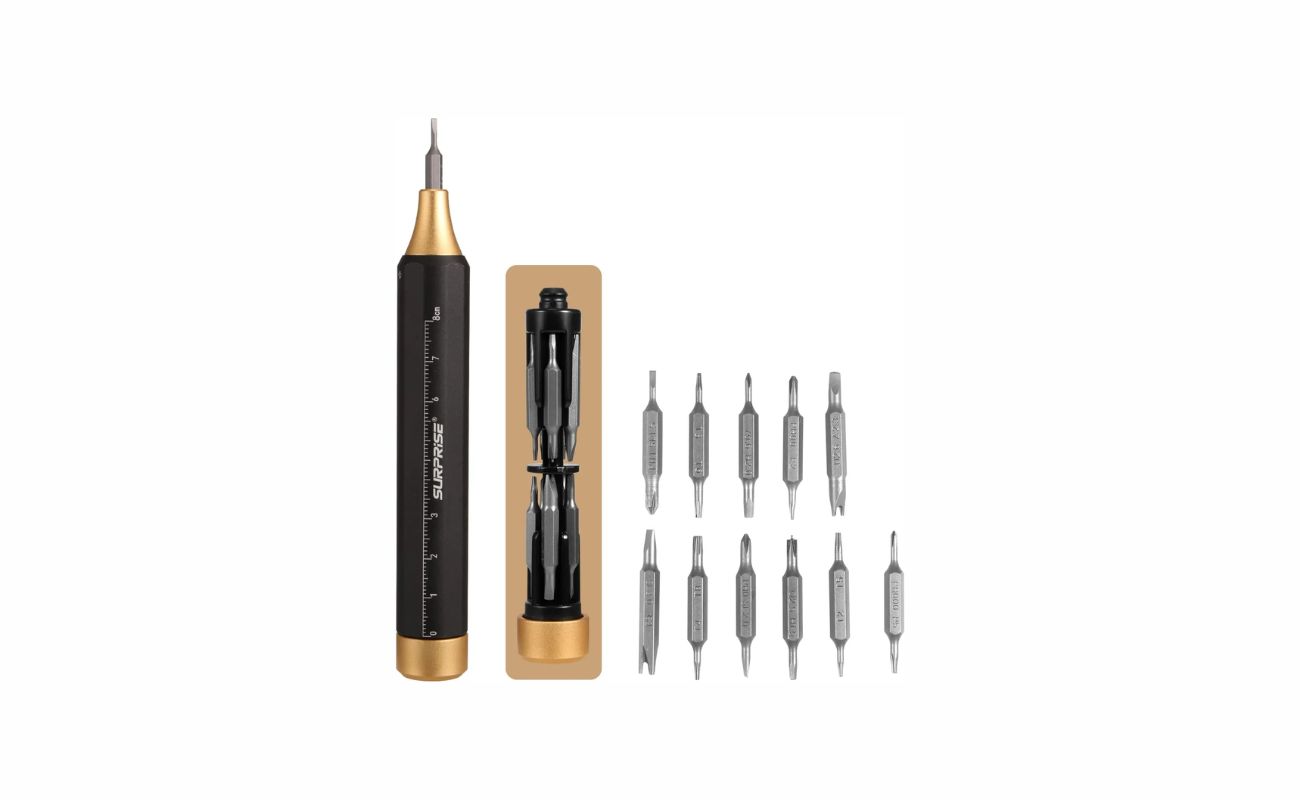Home>Renovation & DIY>Tools & Equipment>What Can I Use Instead Of A Tri-Wing Screwdriver


Tools & Equipment
What Can I Use Instead Of A Tri-Wing Screwdriver
Modified: May 6, 2024
Looking for alternatives to a tri-wing screwdriver? Explore a wide range of tools and equipment options to tackle your projects without the need for specialized screwdrivers.
(Many of the links in this article redirect to a specific reviewed product. Your purchase of these products through affiliate links helps to generate commission for Storables.com, at no extra cost. Learn more)
Introduction
When it comes to tools and equipment, having the right one for the job is essential. Whether you’re a DIY enthusiast or a professional handyman, having a well-stocked toolbox is crucial for tackling various projects. One tool that often comes in handy is a screwdriver. These versatile tools are used for tightening or loosening screws, and they come in different types and sizes to accommodate various screw heads.
In some cases, you may encounter screws with unique or proprietary designs that require specialized screwdrivers. One such example is the tri-wing screwdriver, which is used for screws with three wings or slots. These screws are commonly found in electronic devices, such as video game consoles, laptops, and smartphones. While tri-wing screwdrivers are designed specifically for these screws, you may find yourself in a situation where you need an alternative solution.
This article will provide you with an overview of tri-wing screwdrivers, discuss the reasons why you may need alternatives, and delve into some common alternatives that can be used instead. Additionally, we’ll explore some DIY alternatives that you can easily create using everyday household items. By the end of this article, you’ll have a better understanding of the options available to you when you encounter tri-wing screws and don’t have a dedicated screwdriver at hand.
Key Takeaways:
- Don’t have a tri-wing screwdriver? Common alternatives like flathead and Phillips screwdrivers, Torx screwdrivers, hex keys, and pentalobe screwdrivers can save the day in a pinch.
- In a DIY bind? Everyday items like rubber bands, needle-nose pliers, paperclips, and modified flathead screwdrivers offer makeshift solutions for tackling tri-wing screws.
Read more: What Size Tri Wing Screwdriver For GBA
Overview of Tri-Wing Screwdrivers
Tri-wing screwdrivers are specifically designed to fit screws with three wings or slots. The screws contain three equally spaced slots, forming a triangle shape. These screws are commonly used in electronic devices, particularly in products from certain manufacturers, such as Nintendo for their gaming consoles. Tri-wing screws are intended to provide tamper resistance and prevent unauthorized access to the device’s internal components.
Tri-wing screwdrivers feature a shaft with a triangular-shaped tip that matches the screw’s pattern. The tip of the screwdriver is inserted into the screw, allowing the user to apply torque and twist the screw either clockwise to tighten it or counterclockwise to loosen it. This specialized design ensures a secure and precise fit, minimizing the risk of stripping or damaging the screw head.
Tri-wing screwdrivers come in different sizes to accommodate various screw head dimensions. It’s essential to select the correct size that matches the screw head you’re working with to ensure compatibility and prevent any damage to the screw or the screwdriver itself. Additionally, some tri-wing screwdrivers may have additional features like a magnetic tip or a comfortable handle for enhanced convenience during use.
While tri-wing screwdrivers are specifically designed for tri-wing screws, they may not be as widely available or commonly found in general-purpose toolkits compared to other types of screwdrivers. This can pose a challenge when you encounter tri-wing screws and don’t have the specialized screwdriver on hand. In such situations, knowing the alternatives can help you overcome this obstacle and successfully complete your task.
Reasons to Consider Alternatives
There are several reasons why you might want to consider alternatives to using a tri-wing screwdriver:
- Limited availability: Tri-wing screwdrivers may not be readily available in your local hardware store or included in standard toolkits. This can make it challenging to find and purchase one when needed.
- Cost: Purchasing a specialized tri-wing screwdriver can be relatively expensive, especially if you don’t anticipate using it frequently. Opting for alternatives can save you money.
- Diversity of screws: While tri-wing screws are commonly found in electronic devices, they are not as prevalent in other areas. Having alternatives allows you to be prepared for a broader range of screw types you may encounter.
- Space efficiency: Carrying multiple specialized screwdrivers can take up valuable space in your toolbox. Utilizing alternative options can help streamline your tool collection and free up space for other tools.
- Emergency situations: In emergency situations where a tri-wing screwdriver is not readily available, having alternative options can help you quickly address the issue and make necessary repairs or adjustments.
Considering these reasons, it’s advantageous to have knowledge of alternative methods and tools that can effectively replace the need for a tri-wing screwdriver. By exploring these alternatives, you can save time, money, and effort while still achieving the desired results.
Common Alternatives to Tri-Wing Screwdrivers
If you don’t have a tri-wing screwdriver at hand, there are several common alternatives that you can use to remove or tighten tri-wing screws. These alternatives include:
- Flathead Screwdriver: Flathead screwdrivers have a single flat blade that can fit into the notches of a tri-wing screw. While they may not provide the same level of precision as a dedicated tri-wing screwdriver, they can still be effective in removing or tightening tri-wing screws, especially if the screws are not overtightened.
- Phillips Screwdriver: Phillips screwdrivers feature a cross-shaped tip, which is different from the tri-wing screw pattern. However, in some cases, a Phillips screwdriver with a narrow tip may be able to grip the edges of a tri-wing screw and provide enough torque to loosen or tighten it.
- Torx Screwdriver: Torx screwdrivers are designed for screws with a six-point star-shaped pattern. However, the smaller sizes of Torx screwdrivers, such as T5 or T6, may be able to fit into the notches of a tri-wing screw and exert enough force to turn it.
- Hex Key (Allen Key): Hex keys, also known as Allen keys, are L-shaped metal tools with a hexagonal-shaped tip. In some cases, a smaller-sized hex key might fit into the notches of a tri-wing screw and allow you to turn it.
- Pentalobe Screwdriver: Pentalobe screwdrivers are specifically designed for screws with a five-point star-shaped pattern, commonly found in Apple products. However, in some instances, a smaller-sized pentalobe screwdriver may be able to grip the notches of a tri-wing screw and provide enough torque to manipulate it.
It’s important to note that while these alternatives may work in certain situations, they may not provide the same level of precision or fit as a dedicated tri-wing screwdriver. Therefore, it’s recommended to use them with caution and ensure that you are applying the right amount of force to avoid damaging the screw or the object it is securing.
Ultimately, having these common alternatives on hand can provide you with a viable solution when you don’t have access to a tri-wing screwdriver.
Common Alternatives to Tri-Wing Screwdrivers
Read more: What Can You Use Instead Of A Screwdriver
– Flathead Screwdriver
A flathead screwdriver is one of the most commonly used types of screwdrivers. It features a single flat blade that can fit into the notches of a tri-wing screw to apply torque. While it may not provide the same level of precision as a dedicated tri-wing screwdriver, it can still be used as an alternative in certain situations.
To use a flathead screwdriver as a substitute for a tri-wing screwdriver, follow these steps:
- Select a flathead screwdriver with a blade width that closely matches the width of the notches in the tri-wing screw.
- Ensure that the flathead screwdriver is securely inserted into the notches of the tri-wing screw.
- Apply gentle and even pressure while turning the screwdriver counterclockwise to loosen or clockwise to tighten the tri-wing screw.
- Maintain a firm grip on the screwdriver to prevent slipping and minimize the risk of damaging the screw or surrounding components.
It’s important to note that a flathead screwdriver may not provide the same level of grip and stability as a dedicated tri-wing screwdriver, so exercise caution while using this alternative. Additionally, flathead screwdrivers are more suitable for tri-wing screws that are not overtightened or stubbornly stuck. If the screw is excessively tight or corroded, it’s advisable to seek a more suitable alternative or invest in a tri-wing screwdriver.
Overall, while a flathead screwdriver may not be the ideal tool for tri-wing screws, it can serve as a temporary solution in situations where a dedicated tri-wing screwdriver is unavailable.
Common Alternatives to Tri-Wing Screwdrivers
– Phillips Screwdriver
A Phillips screwdriver is a popular type of screwdriver characterized by its cross-shaped tip. While it is not specifically designed for tri-wing screws, a Phillips screwdriver can sometimes be used as a makeshift alternative when a tri-wing screwdriver is unavailable.
To use a Phillips screwdriver as an alternative to a tri-wing screwdriver, follow these steps:
- Select a Phillips screwdriver with a narrow tip that closely matches the size of the notches in the tri-wing screw.
- Position the Phillips screwdriver at an angle, ensuring that the edges of the cross-shaped tip engage with the edges of the tri-wing screw.
- Apply steady and even pressure while turning the screwdriver counterclockwise to loosen or clockwise to tighten the tri-wing screw.
- Ensure that the screwdriver remains securely inserted and prevent it from slipping to avoid damaging the screw or surrounding components.
It’s important to note that using a Phillips screwdriver as an alternative to a tri-wing screwdriver may not yield the same level of precision and grip. Additionally, this method is more effective for tri-wing screws that are not overtightened or severely stuck. If the tri-wing screw is excessively tight or difficult to turn, it’s advisable to seek a more suitable alternative or obtain a tri-wing screwdriver.
While a Phillips screwdriver may not be the optimal choice for tri-wing screws, it can serve as a temporary solution in situations where a dedicated tri-wing screwdriver is not available. However, exercise caution and ensure that you are applying the correct amount of force to prevent damage to the screw or the object it is securing.
Common Alternatives to Tri-Wing Screwdrivers
– Torx Screwdriver
A Torx screwdriver is designed for screws with a six-point star-shaped pattern. While it may not be specifically made for tri-wing screws, a smaller-sized Torx screwdriver can sometimes be used as an alternative when a dedicated tri-wing screwdriver is not available.
To use a Torx screwdriver as an alternative to a tri-wing screwdriver, follow these steps:
- Select a smaller-sized Torx screwdriver, such as T5 or T6, that can fit securely into the notches of the tri-wing screw.
- Insert the Torx screwdriver into the notches of the tri-wing screw, ensuring a proper fit.
- Apply steady and even pressure while turning the screwdriver counterclockwise to loosen or clockwise to tighten the tri-wing screw.
- Keep a firm grip on the screwdriver to prevent slipping and minimize the risk of damaging the screw or surrounding components.
It’s important to note that a Torx screwdriver may not provide the same level of precision and fit as a dedicated tri-wing screwdriver. Furthermore, this alternative method is more effective for tri-wing screws that are not excessively tight or stubbornly stuck. If the tri-wing screw is extremely tight or corroded, it’s advisable to seek a more suitable alternative or acquire a tri-wing screwdriver.
While a Torx screwdriver may not be the perfect match for tri-wing screws, it can serve as a temporary solution in situations where a dedicated tri-wing screwdriver is unavailable. However, exercise caution and ensure that you are using the correct size of the Torx screwdriver to avoid damaging the screw or the object it is securing.
Common Alternatives to Tri-Wing Screwdrivers
– Hex Key (Allen Key)
A hex key, also known as an Allen key, is a versatile tool that is commonly used to tighten or loosen screws with hexagonal-shaped heads. While it is not specifically designed for tri-wing screws, a smaller-sized hex key can sometimes be used as an alternative when a tri-wing screwdriver is not available.
To use a hex key as an alternative to a tri-wing screwdriver, follow these steps:
- Select a smaller-sized hex key that closely fits into the notches of the tri-wing screw.
- Insert the hex key into the notches of the tri-wing screw, ensuring a proper fit.
- Apply steady and even pressure while turning the hex key counterclockwise to loosen or clockwise to tighten the tri-wing screw.
- Maintain a firm grip on the hex key to prevent it from slipping and minimize the risk of damaging the screw or the surrounding components.
It’s important to note that using a hex key as an alternative to a tri-wing screwdriver may not provide the same level of precision and grip. Additionally, this method is more effective for tri-wing screws that are not overtightened or stubbornly stuck. If the tri-wing screw is excessively tight or corroded, it’s advisable to seek a more suitable alternative or obtain a tri-wing screwdriver.
While a hex key may not be the ideal tool for tri-wing screws, it can serve as a temporary solution in situations where a dedicated tri-wing screwdriver is unavailable. However, exercise caution and ensure that you are using the correct size of the hex key to prevent damage to the screw or the object it is securing.
Common Alternatives to Tri-Wing Screwdrivers
– Pentalobe Screwdriver
A pentalobe screwdriver is a specialized tool designed specifically for screws with a five-point star-shaped pattern. While it is not intended for tri-wing screws, a smaller-sized pentalobe screwdriver can sometimes be used as an alternative when a dedicated tri-wing screwdriver is unavailable.
To use a pentalobe screwdriver as an alternative to a tri-wing screwdriver, follow these steps:
- Select a smaller-sized pentalobe screwdriver that can fit securely into the notches of the tri-wing screw.
- Insert the pentalobe screwdriver into the notches of the tri-wing screw, ensuring a proper fit.
- Apply steady and even pressure while turning the screwdriver counterclockwise to loosen or clockwise to tighten the tri-wing screw.
- Maintain a firm grip on the screwdriver to prevent slipping and minimize the risk of damaging the screw or the surrounding components.
It’s important to note that using a pentalobe screwdriver as an alternative to a tri-wing screwdriver may not provide the same level of precision and fit. Additionally, this method is more effective for tri-wing screws that are not overtightened or stubbornly stuck. If the tri-wing screw is excessively tight or corroded, it’s advisable to seek a more suitable alternative or obtain a tri-wing screwdriver.
While a pentalobe screwdriver may not be the ideal tool for tri-wing screws, it can serve as a temporary solution in situations where a dedicated tri-wing screwdriver is not available. However, exercise caution and ensure that you are using the correct size of the pentalobe screwdriver to avoid damaging the screw or the object it is securing.
DIY Alternatives
If you don’t have access to any of the common alternatives mentioned earlier, you can also consider creating your own makeshift tools using everyday household items. Here are a few DIY alternatives that you can try:
- Rubber Band: Wrap a rubber band tightly around the head of the tri-wing screw. This can provide additional grip and prevent the screwdriver from slipping, allowing you to turn the screw.
- Needle Nose Pliers: If you have a pair of needle-nose pliers with thin and narrow tips, you can carefully insert the tips into the notches of the tri-wing screw and use them to turn the screw.
- Paperclip: Straighten out a sturdy paperclip and bend it into an L-shape. Insert the longer end of the paperclip into the notches of the tri-wing screw and use it as a makeshift screwdriver.
- Small Flathead Screwdriver and Tape: If you have a small flathead screwdriver that is slightly wider than the notches of the tri-wing screw, you can cover the tip of the screwdriver in tape to increase its width. This additional width can help the screwdriver engage with the notches more securely.
While these DIY alternatives may not be as effective or precise as dedicated tri-wing screwdrivers, they can provide you with a temporary solution in a pinch, allowing you to remove or tighten tri-wing screws when you don’t have the correct tool on hand.
It’s important to exercise caution and use these DIY alternatives with care, as there is a higher risk of damaging the screw or the surrounding components due to the lack of specialized tools. If possible, it is always recommended to obtain the appropriate screwdriver for the job or seek professional assistance.
Remember, DIY alternatives should be seen as temporary solutions and not a substitute for the proper tools needed for the job.
Conclusion
Encountering tri-wing screws without a dedicated tri-wing screwdriver can be a frustrating obstacle, but with the knowledge of common alternatives and DIY solutions, you can successfully tackle this challenge. While tri-wing screwdrivers are specifically designed for these unique screws, they may not always be readily available or cost-effective. That’s where the importance of exploring alternatives comes into play.
In this article, we discussed the overview of tri-wing screwdrivers, highlighting their purpose and design. We then explored the reasons to consider alternatives, including limited availability, cost, diversity of screws, space efficiency, and emergency situations. We also delved into the common alternatives that you can use instead, such as flathead screwdrivers, Phillips screwdrivers, Torx screwdrivers, hex keys (Allen keys), and pentalobe screwdrivers. These alternatives may not be perfect matches for tri-wing screws, but they can serve as viable alternatives in certain circumstances.
Furthermore, we discussed the DIY alternatives that you can create using everyday household items, including rubber bands, needle-nose pliers, paperclips, and small flathead screwdrivers with tape. These DIY alternatives provide temporary solutions when you find yourself without the appropriate tools.
It’s important to remember that while these alternatives can be helpful in a pinch, they may not offer the same level of precision or reliability as dedicated tri-wing screwdrivers. It’s always recommended to use the correct tool for the job when possible or seek professional assistance when needed.
In conclusion, having a good understanding of the alternatives to tri-wing screwdrivers equips you with the knowledge and resourcefulness to handle tri-wing screws in various situations. Whether it’s using common alternatives or DIY solutions, you can overcome the challenge of working with tri-wing screws and complete your projects successfully.
Now that you've got a handle on tri-wing screwdriver alternatives, why not keep up the momentum with your DIY skills? Dive into our next read, where we cover essential home upkeep routines. Maintaining your living space shouldn't be a chore, but rather a rewarding part of homeownership. Our guide breaks down simple yet effective steps to keep your house in tip-top condition all year round. Don't miss out on these practical insights!
Frequently Asked Questions about What Can I Use Instead Of A Tri-Wing Screwdriver
Was this page helpful?
At Storables.com, we guarantee accurate and reliable information. Our content, validated by Expert Board Contributors, is crafted following stringent Editorial Policies. We're committed to providing you with well-researched, expert-backed insights for all your informational needs.













0 thoughts on “What Can I Use Instead Of A Tri-Wing Screwdriver”